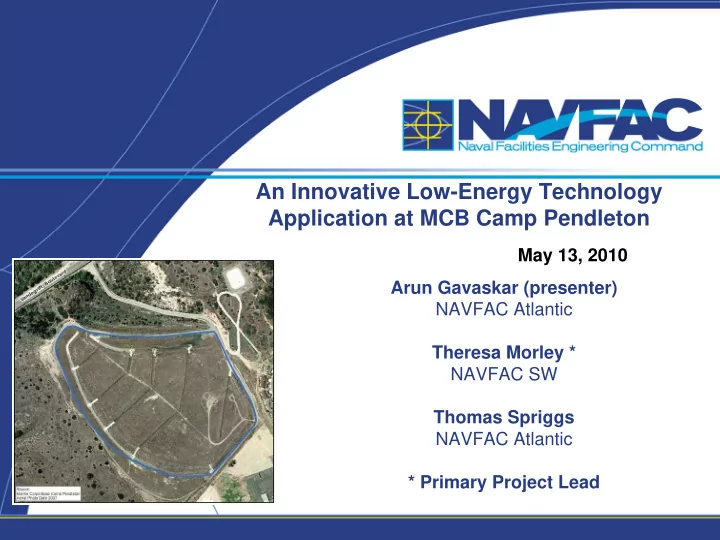

An Innovative Low-Energy Technology Application at MCB Camp Pendleton May 13, 2010 Arun Gavaskar (presenter) NAVFAC Atlantic Theresa Morley * NAVFAC SW Thomas Spriggs NAVFAC Atlantic * Primary Project Lead
Overview of the Box Canyon Landfill GSR Project • Location of Box Canyon (Site 7) Landfill • History of Site 7 Landfill • Laying the Groundwork to Use GSR • Challenges to Incorporating GSR Projects – Regulatory Acceptance – Construction on Existing Landfill Cap • GSR Projects at MCB Camp Pendleton’s Landfill, Site 7 – Photovoltaic Project – Methane Micro-turbine Project 2
Regional Location of MCB Camp Pendleton 3
Specific Location of Box Canyon (Site 7) Landfill 4
History of the Box Canyon (Site 7) Landfill • Landfill encompasses a 28-acre open area • CAMU built next to a housing and elementary school on open municipal landfill • Later lawsuit resulted in the only toxic tort case in Navy’s history • Area continues to be a source of constant concern to State agencies • Monitored methane gas levels fluctuate in and out of compliance • Ongoing activities: – Landfill gas monitoring – Groundwater monitoring – Site maintenance 5
Laying the Groundwork for GSR Projects at the Site 7 Landfill • Idea for photovoltaic (PV) panels onsite came from Mike Montgomery (Region IX Branch Chief) on a site tour • MCB Camp Pendleton submitted request for $10M from the American Recovery and Reinvestment Act (ARRA) – Many strings attached, including an expedited schedule – Design complete, construction must start no later than 6 months after award • Met with legal counsel, base, EPA and their attorneys to negotiate an ESD instead of a ROD Amendment • Presented concept to the remaining Federal Facilities Agency (FFA) members supported by the EPA – important to note – resulting in a change in land use, not a remedy 6
Aerial View of Site 7 Landfill 7
Agency Concerns to Incorporating GSR Construction on an Existing Landfill Cap • Settlement • Bearing capacity of soil • Stability • Displacement • Controlling erosion/soil loss • Drainage control • Infiltration • Site access • Landfill gas control system (not affected by design) 8
Site 7 Landfill Cap Drainage Plan 9
Design Specifications to Address Agency Concerns Infiltration • Approved vegetation list provided by NAVFAC SW biologist – Array area: short growth (<3 ft tall) & shade tolerant – In-between rows: “hearty” vegetation • During construction, minimize disturbance to existing vegetation • Conduct system O&M every 6 months, including vegetation checks Site Access • Existing improved surfaces will remain • No additional improvements will be needed 10
Photovoltaic (PV) System Design Specs Photovoltaic Design Specifications • 1.48 MW (DC) capacity • System made up of 220, 28-module 6.6 kW building blocks • Each panel has a fixed 15 ° tilt, 190 ° orientation Construction Specifications • Units are built on self-ballasted, non-penetrating foundations • Gravel interface between ballasts and landfill cover • Adjustable system structure components • Spacing between modules (maintenance) • No excavation of the existing ET cover 11
Photovoltaic Layout Plan (~50% Design) 12
Site 7 Landfill P/V & Transmission Plan 13
Methane Gas Collection: Microturbine System Design Specs • GeoSyntec approached the Navy with GSR solution for continuing methane problem • Proposed a 30kW microturbine connected to methane gas collection wells and energy produced fed into PV panel system • Microturbine is the size of an industrial refrigerator – Cannot see unit from the housing complex or school – Unit runs quiet w/o a flare; optional night operation • System most adaptable to low methane production and fluctuations in gas volumes 14
Methane Gas Flow 15
Proposed Gas Collection Layout 16
Proposed Gas Collection and Energy Production Schematic 17
Summary • Exciting opportunity to incorporate GSR on an existing, open IR site, i.e., ‘clean slate’ • Key to success was working with other agencies to meet Navy sustainability goals • Key design criteria critical to success: – Counter-balanced, non-penetrating foundations will avoid construction into the existing landfill cap – High efficiency, fixed orientation, and modular PV cell units – Incorporating appropriate vegetation for use around PV cells – State-of-the-art microturbine capable of running efficiently at low methane concentrations (~7%) – Utilizing two GSR technologies at the same facility 18
Solar Power – General Issues to Consider • Disturbs pristine desert environments (not an issue with landfills) • May require cooling water, which is hard to find in deserts (the sunniest areas) • A single solar panel generates very little electricity, so vast array is required • Mechanical system required to keep panels adjusted towards the sun at all times • Maintenance costs, weathering of expensive panels under the impact of the elements will need to be studied • Need supplemental source of power during cloudy days, nights • Carbon neutrality needs to be established on the basis of life cycle analysis. Specialty chemicals that go into solar panel manufacture have their own carbon footprint. 19
Microturbines – General Issues to Consider • 11 operational projects (land fill gas microturbines) ) in California, utilizing 50 turbines, generating 2.7 MW of power • Microturbines use 35% more fuel per kWH produced, compared to standard reciprocating engines and conventional turbines (US EPA, 2002) • Energy produced may be sporadic, supplemental sources of power needed • Maintenance requirements need to be tracked in the future • Compressed landfill gas projects may also be worth looking at 20
Follow-up Contacts MCB Camp Pendleton RPM: Theresa Morley, NAVFAC SW Theresa.Morley@navy.mil (619) 532-1502 Green & Sustainable Remediation: Tom Spriggs, NAVFAC LANT Thomas.Spriggs@navy.mil (757) 322-4335 21
Recommend
More recommend